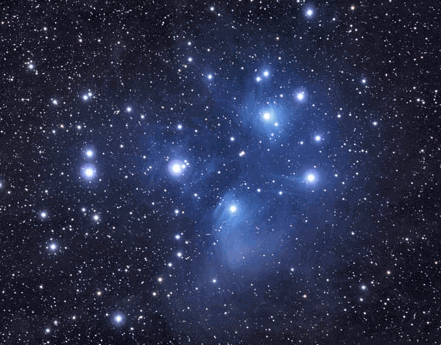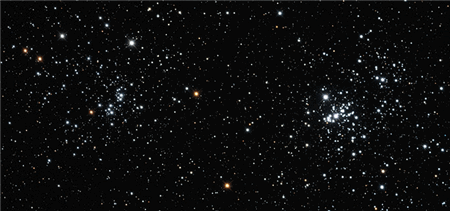Star clusters form from the same molecular cloud. An
open cluster of stars is one that can contain about
a dozen to a few hundred members. In addition, they
are spaced loosely and are generally younger, hot
stars.Open clusters are commonly found in the
disk of a
galaxy.
Examples of Open Clusters:
The Pleiades open cluster is a group of newly
formed B-type stars. This 115 million year-old open cluster is easily visible with the naked eye. The brightest stars have a surface temperature of 30,000 Kelvin, however there are other stars that are a part of the cluster that have a variety of temperatures much cooler than these.

(© 2005 Russell Croman,
www.rc-astro.com)
The Persius double-cluster is a remarkable site.
This is actually a two open clusters.

(© 2005 Russell Croman,
www.rc-astro.com) Star clusters give
astronomers a unique opportunity. All we know about
stellar evolution come from star clusters (both open
and closed). Stars in a cluster form at different
times because of a variety of masses, but all
contain nearly the same
spectroscopic data. By
careful observation, a
Color-Magnitude Diagram can
be created to plot the progression of evolution. A
Color-Magnitude Diagram (or CMD) is really a
specialized H-R diagram:

(Image credit: Brooks/Cole Thomson Learning) The
organization of stars on the diagram give us the age
of the cluster. By evaluating when stars enter the
later stages of evolution - called the Main-Sequence
Turn Off Point - we can determine the age of the
cluster. Sometimes the mutual gravity of a
cluster cannot hold the cluster together. This
results in an stellar association. The most common
member of a stellar association are O and B type
stars. As a result, the correct term is OB
Association. Here is a summary chart of star
clusters:
| Characteristic: |
Open Clusters: |
OB Associations: |
Globular Clusters: |
| Diameter (pc): |
<10 |
30 - 200 |
20 - 100 |
| Number of Stars: |
50- 1000 |
10 - 100 |
104 - 106 |
| Mass (Solar): |
100 - 1000 |
100 - 1000 |
104 - 106 |
| Density (Solar
Mass/pc3): |
0.1 - 10 |
<0.01 |
0.5 - 1000 |
| Shape: |
Irregular |
Irregular |
Spherical |
| Color (Common): |
Red or Blue |
Blue |
Red |
| Metallicity: |
High |
High |
Low |
| Location: |
Disk of Galaxy |
Disk of Galaxy |
Halo of Galaxy |
Back to
Top |

